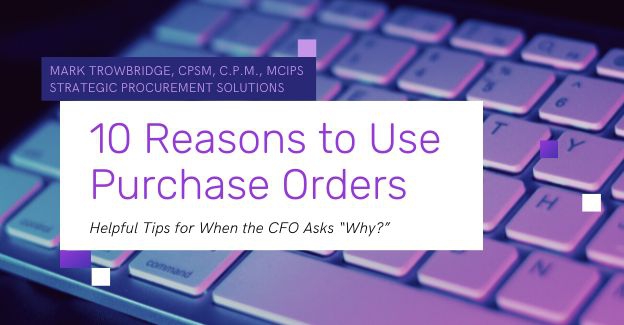Procurement groups are often challenged by internal Line-of-Business (LOB) groups on requiring purchase orders says Mark Trowbridge CPSM, C.P.M., MCIPS, Principal with Strategic Procurement Solutions LLC. He outlines 10 key reasons to use purchase orders, discusses when other acquisition methods may also apply and provides helpful tips for when the CFO asks "why".
The CPO for a financial services company recently asked me for reasons to use purchase orders. Their procurement group was receiving pushback from the firm's Finance division, which was happy to issue payments merely based on internal management just "approving" supplier invoices (grrr).
In my email to this executive, I put together a list of Top 10 Reasons to Use Purchase Orders which I’ll explain in this article.
Top 10 Reasons to Use Purchase Orders
Reason One - Online approval prior to PO issuance ensures the expenditure is budgeted and authorized before a commitment is made to a supplier. With invoice-only payment processing, an organization is already liable for the expenditure even though it was never approved by management.
Today’s e-enabled PO routing and approval process ensures that only authorized company representatives can commit to supplier expenditures. This focuses supplier relationships through the procurement organization.
Reason Two – If a PO is a requirement before a supplier can be paid, they won't start work for a business without it. Word travels fast in the supplier community, and can be aided by an email to each supplier reminding them that a purchase order number is required on all invoices.
This will keep control in the procurement organization and prevent suppliers from shipping products or beginning work without prior purchase order approval being in place.
Reason Three – Use of purchase orders greatly-improves capture of payment term discounts (i.e., “2% 10 – Net 30 Days”) negotiated by the procurement team. Contrarily, invoice-only transactions often default to the supplier’s invoice payment terms which rarely offer cash discounts. 11% to 12% of a typical company’s suppliers will agree to discounted terms in payment – if they are strategically asked.
Reason Four – It has been documented in many studies that material errors exist more than 1.5% of invoice line items billed by suppliers. Most of the time the error is to the benefit of the supplier (hmmm, what a coincidence...). Having PO/invoice matching catches a majority of the errors and does not allow them to be passed through without review.
When our firm performed a review for this same financial services firm, their Accounts Payable organization was processing around 55,000 invoices a year valued around $200 million USD. If we assume the average invoice contains two line items, that's 110,000 invoice line items being paid each year, indicating that there are about 1,600 (1.5%) line items having material errors. Dividing annual spending by 110,000 line items results in an average line item value of $1,818/line item, thus indicating $3.0 million of questionable charges that purchase orders would properly flag for investigation.
It should also be noted here that even with purchase orders being used, a typical AP recovery audit still recaptures around 1.0% of errors in the payment stream. Interestingly, the “disruptor” provider in this space averages 50% higher recovery than their peers through some innovative techniques and especially for clients that link purchase orders to most invoice payments (you can contact me for the name of disruptor).
Reason Five – Use of a purchase order streamlines payment processing, since the processor doesn't have to enter line item details. They should pull up the purchase order and its line item description and insert the billed quantity. The other information fills automatically into the invoice record with much greater detail than allowing different AP clerks' subjective one word summary entry of the transaction.
For example, "Metal" rather than "4' x 8' Sheet of 6061-T6 Aluminum." For non-catalog ordering, use of POs greatly improves spend analysis data quality.
Reason Six – Use of a purchase order ensures the charge goes to the GL account, charge unit and project number the PO was budgeted to. "Creative" budget owners can't shift the expense to a different GL account.
Reason Seven - A purchase order should contain legal terms that mitigate risk in transactions. Even if it does not occur under a contract, the supplier's terms don't prevail. In an invoice-only transaction, the supplier's proposal/quotation legal terms could control the transaction, thus exposing the buying organization to greater risk on issues like title transfer, risk of loss during shipment, payment terms, freight costs, warranty, third-party patent infringement, ownership of work product, limitation of restocking fees, etc.
Reason Eight – A purchase order causes an organization to clearly articulate what they wish to buy from a supplier. If the supplier questions a description, they will usually do that before shipment/performance. But without a PO, the supplier is open to interpret a telephone or email order incorrectly, resulting in a miss-shipment. That results in the business unit having to facilitate a return to the supplier, and procurement will usually end up having to clean up the mess. Returns are much easier when a purchase order has been utilized.
Reason Nine – A purchase order allows procurement to have visibility to backorders or partial shipments, thus facilitating follow ups and expediting. Without a PO, no one knows what hasn't been shipped, just what has been invoiced.
Reason Ten – When three-way matching is empowered, a purchase order facilitates formal “receiving” to validate received shipments. Without a purchase order, you have no formal receiving process except for AP to send an invoice to the business unit asking them for approval. The business unit often will not dispute slightly different quantities in an invoice and procurement never is notified payment has been approved for something that wasn't actually received.
The Bottom Line
Consistent use of purchase orders will optimize the entire Procure-to-Payment process. Even contracted expenditures will be better-managed through purchase orders by ensuring spending can be properly allocated to correct contracts, SOWs and projects.
Of course, not every expenditure needs to be under a purchase order. Use of other techniques like pCards or Evaluated Receipt Settlement (ERS) can be similarly valuable when used optimally. But purchase orders are the preferred tool for the majority of procurement transactions; especially when automated though a Procure-to-Pay (P2P) technology solution.
Even more exciting today, purchase orders used with rebate-generating Virtual Card (vCard) payment processes are more secure than ACH or checks (and eliminate the need for the buying organization to possess a supplier’s private banking information). The “disruptor” in vCard payments is neither a bank or retail card issuer; yet processes more vCard transactions annually than the Top four U.S. banks combined.
Failure to strategically use purchase orders can allow suppliers and internal departments to bypass procurement and thus executive management.









